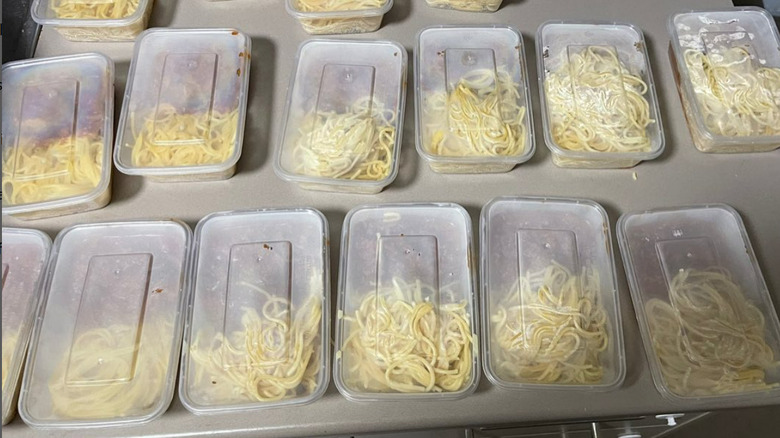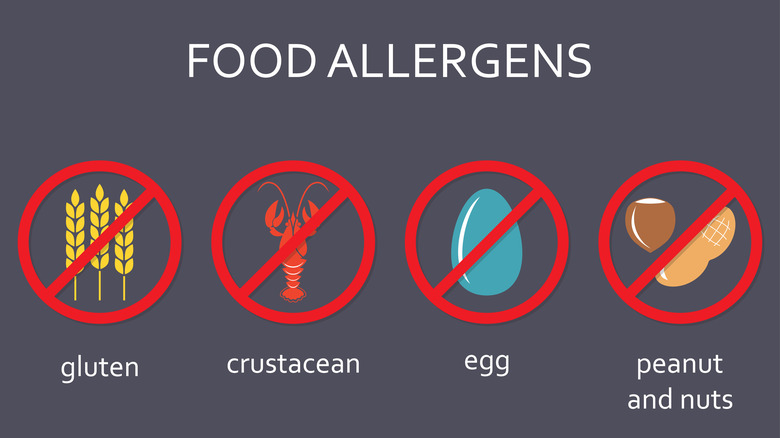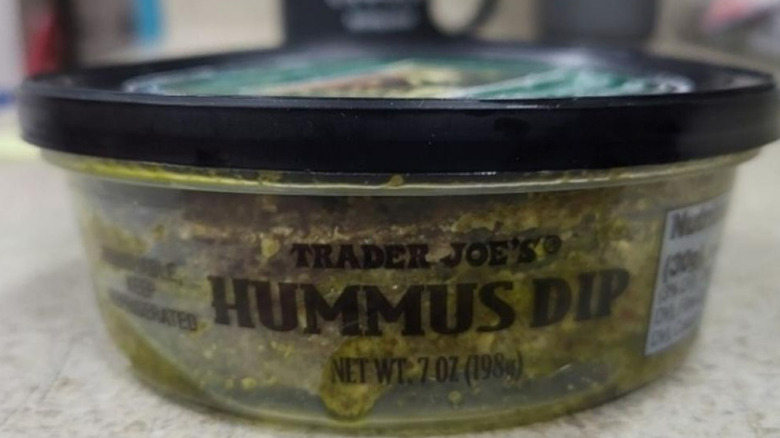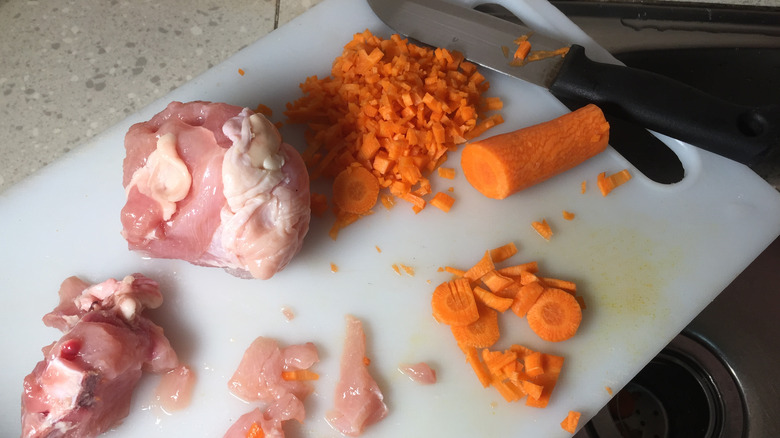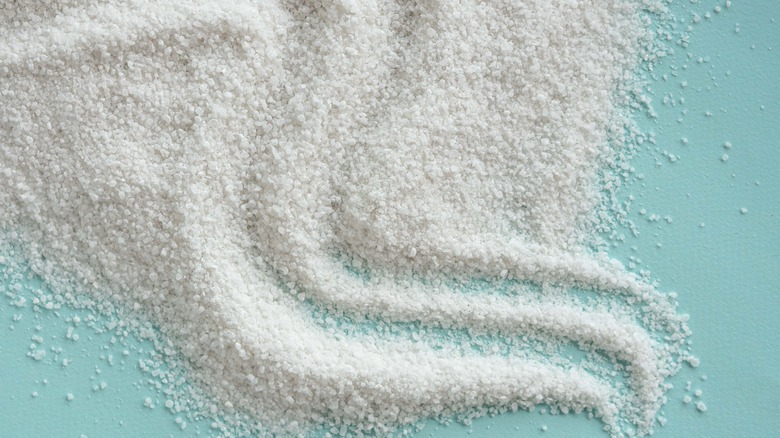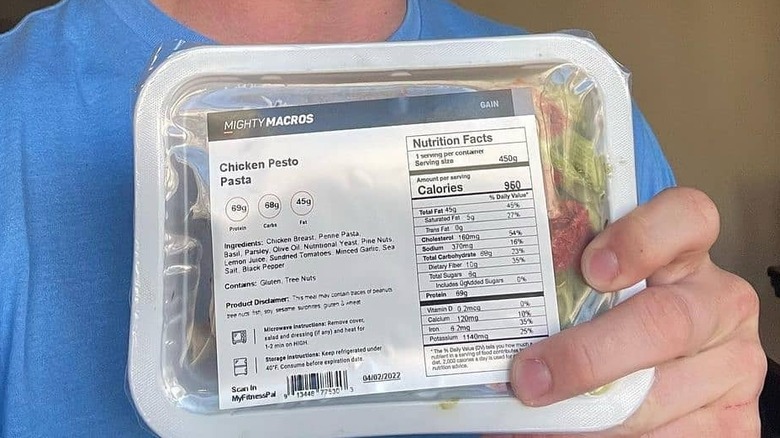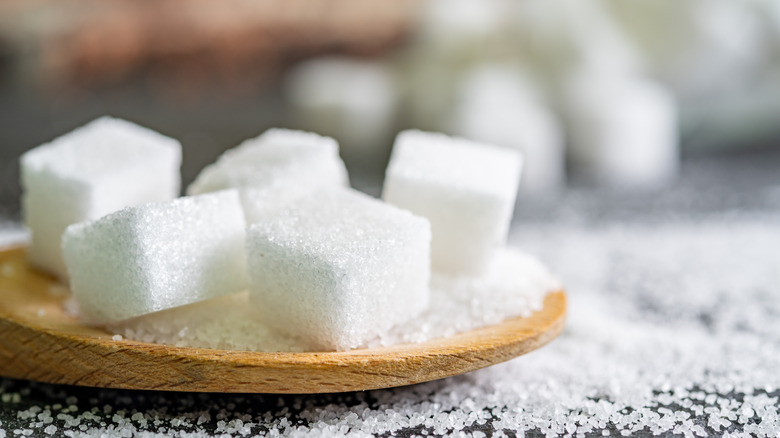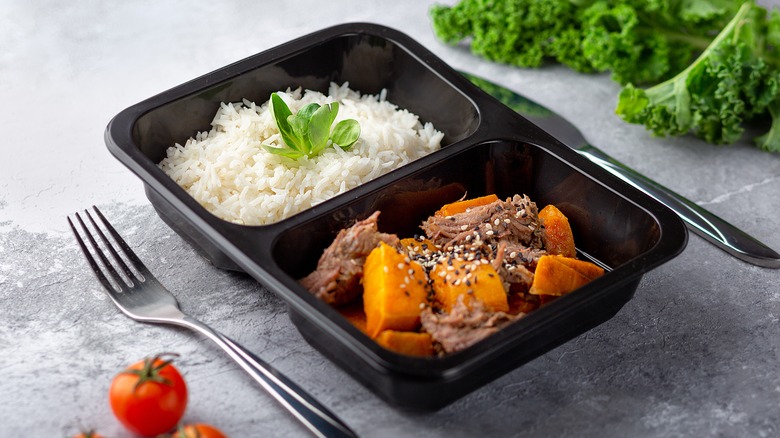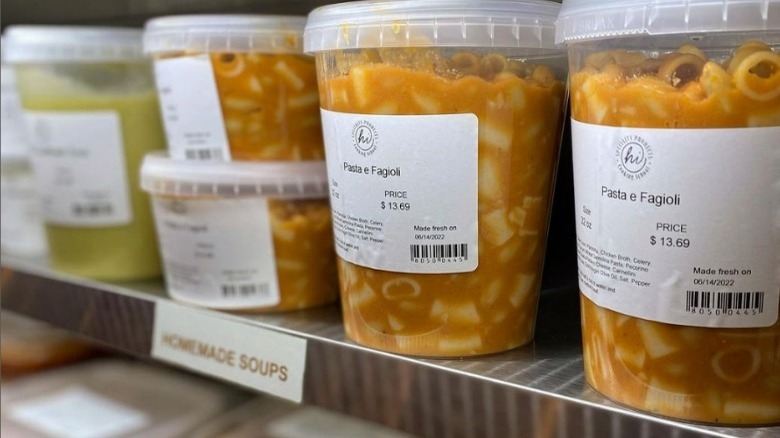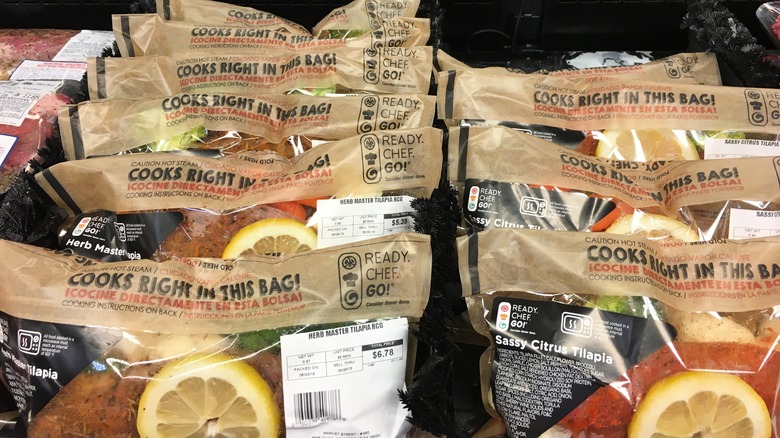What You're Really Eating When You Buy Pre-Made Meals From Grocery Stores
It pays to know the best grocery stores to pick up a pre-made meal. This modern convenience is to the 2020s what sliced bread was to the 1920s: A welcome innovation that could be leveraged easily while making a single stop at the grocery store. Unlike salad bar and buffet foods, which are also available at many supermarkets today, pre-made grocery store meals come cleanly packaged in neat little containers. And in most cases, the instructions encourage us to heat them up in those neat little containers — without dirtying another dish.
But just as sliced bread has managed to acquire its share of critics over the years, so too have pre-made meals. To wit, a 2015 study published in the academic journal, Appetite, begins with quite the damning statement about these foods that were designed to make our lives easier. "Over-reliance on convenience foods, including ready-meals, has been suggested as one contributor to obesity," the authors assert. On the other hand, the authors immediately follow up with the observation that clinical research on the nutritional content and health consequences of consuming "supermarket ready-meals" had been sparse up to that date.
Fortunately, while research on the topic remains in short supply to this day, a lot more is known today than was in 2015. And while it turns out that what you're really eating when you buy pre-made foods from the grocery store isn't quite what we had hoped, it's not all bad either.
Less-than-fresh ingredients
Only about half of the pre-made meals you'll find in grocery stores are prepared on the grocery store premises, according to a Consumer Reports study conducted among grocery stores and published in 2016. Those that aren't made on premises were cooked somewhere else before being packed, refrigerated, transported, unpacked, and re-refrigerated before they get into your hands. In fact, some may even have been frozen in the process and thawed/reheated upon arrival at your local grocer.
Moreover, some of the ingredients used in making the pre-made grocery store meals have come to the kitchen in pre-made form themselves, and sometimes preserved in cans or bottles — pre-made tomato sauce being one that comes quickly to mind. Further, some of the ingredients may have been frozen before they were used to "freshly" make the pre-made grocery store meal.
Not that any of this is "bad," per se. It's just that if you're avoiding preservatives, then pre-made grocery store meals may not be the answer. To determine if you're good, you'll want to study the label for preservatives like benzoic acid, calcium sorbate, potassium sorbate, and sorbic acid, among others. In addition, you may want to think twice about eating the leftovers. If you do, you'll need to reheat them thoroughly — to 165 degrees Fahrenheit, according to the USDA. But keep in mind that this is now the second time you'll be reheating the food, which was cooked for the first time before it came to you.
Undeclared allergens
Federal law requires most packaged foods you can buy in grocery stores be labeled with a "major food allergen" disclosure — i.e., a statement as to the presence of one or more of the nine major food allergens: Milk, egg, fish, shellfish, tree nuts, peanuts, wheat, soybeans, and sesame. Most pre-made grocery store food is labeled appropriately in that respect. However, mistakes do happen. For example, this Trader Joe's recall of one of its most popular ready-made salads came about because it contained undisclosed wheat, one of the major food allergens.
Of course, some people have allergies to foods that are not included on the list of "majors." In fact, more than 170 different foods are associated with allergic reactions in humans, according to Food Allergy Research and Education (FARE). Although most involve the nine majors listed above, some 10% of the 32 million people in the U.S. with food allergies are sensitive to foods that are not. Although no disclosure statement needs to be made about these other potential allergens, they should appear on the ingredient label. Unfortunately, federal law doesn't always require an ingredients list on pre-made food, and some states don't either.
The downside is some pre-made foods are packaged without an ingredients list. Even worse, some of the ingredient lists you see may be less than reliable. For example, Consumer Reports noted that a Stop & Shop spicy tuna roll contained avocado but did not disclose "avocado" in the ingredients list.
Something completely different from the label
Federal law requires most pre-made grocery store meals to disclose the presence of any of the nine major food allergens. Accordingly, you can generally rely on compliance, with the caveat being that human error is always possible; so too is cross-contamination with allergens or otherwise as discussed below. But ingredient lists are another story altogether. Some pre-made food can be sold at grocery stores without an ingredient list on its label. Because ingredient labels are not federally mandated, they're also not overseen, which makes them more apt to contain errors, omissions, and inaccuracies.
For example, Consumer Reports noted that the pre-made turkey meatloaf it examined at The Fresh Market contained salad dressing despite no dressing listed among the ingredients. Likewise, the pre-made tuna roll it examined at Stop & Shop contained undisclosed avocado. Some errors and omissions may cause allergic reactions. Others, such as undisclosed calories, salt, or saturated fat, may pose a less immediate risk but may be problematic for some nevertheless.
There is also some chance — because it has happened before — that store-made food will be placed in the wrong packaging, e.g. with the wrong allergy disclosure and/or ingredients list. This actually happened in May 2023, when a Trader Joe's vendor, Bakkavor U.S.A., filled its Hummus Dip containers with its pesto sauce, as subsequently disclosed on the FDA recalls page.
Potential foodborne contaminants
Pre-made meals from the grocery store may also harbor contaminants — i.e., things that aren't supposed to be there at all. One such type of contaminant is bacteria — the kind that causes foodborne illness, such as any of the potentially life-threatening illnesses caused by Salmonella, E coli, or Listeria bacteria. Pre-made meals present a heightened risk of what's known as cross-contamination because meals tend to involve a variety of foods, not all of which are cooked at temperatures high enough to kill foodborne bacteria (165 degrees Fahrenheit).
For example, if a dish is made with chicken and carrots, and the cook uses the same knife to cut both, the carrots can be contaminated with whatever bacteria is on the chicken. Most likely, the chicken will be cooked to the critical temperature whereas the carrots may not be. Recalls of pre-made foods due to actual or suspected bacterial contamination are a lot more common than any of us would care to think. For example, in February 2023, a vendor of ready-made sandwiches and wraps issued a recall due to potential cross-contamination with Listeria (via the FDA). In April 2023, Meijer recalled pre-made salads due to potential Listeria contamination.
Cross-contamination can also introduce trace amounts of undeclared allergens into pre-made food. In 2020, the FDA issued a warning to Whole Foods for numerous instances of the same in its pre-made foods.
More salt than you might think
Salt makes food taste better, according to the National Library of Medicine. And for better or for worse, the chefs charged with designing the recipes for your pre-made grocery store meals, not to mention the cooks charged with preparing them, know this too. In fact, there's a tendency for pre-made foods to be prepared with generous amounts of salt, and likely more than you'd cook with yourself.
For healthy adults, the American Heart Association recommends that people consume no more than 2,300 mg of sodium per day but suggests a more ideal number to strive for is 1,500. That can be challenging when your ShopRite chicken marsala with potatoes pre-made entree contains 972 mg of sodium per serving, as Consumer Reports noted in its aforementioned report. Further, and as we'll be getting into a bit later, it's not always going to be clear how many servings you're getting in your package. And it's likely your idea of a serving is bigger than your vendor's.
Of course, we don't mean to single out ShopRite, not when the 2015 study published in Appetite, which analyzed 166 pre-made meals from 41 stores, concluded that all of the meals tended to be high in salt, and that included some portion of the meals labeled as "healthier" selections. On the other hand, our own Jeff Mauro-inspired chicken marsala recipe contains one-third less sodium than the store-bought pre-made stuff. When cooking at home, it's very easy to control the amount of sodium you consume.
A generous serving of saturated fat
In addition to salt, pre-made supermarket meals tend to be high also in saturated fat, according to findings in the 2015 study published in the journal, Appetite. Sources of saturated fat, which you'll recognize by its solid state at room temperature, include butter, cheese, red meat, poultry, lamb, and pork — all of which are used quite often as ingredients in pre-made meals from the grocery store and elsewhere.
Saturated fat is one of the types of fats that scientists, including cardiologists, would rather you strictly limit (the other is trans fat). Habitual consumption of more than the recommended allowance can cause blood levels of LDL cholesterol (i.e., the bad one) to rise, which can, in turn, increase your risk of heart disease and stroke. The American Heart Association recommends that adults limit their daily consumption of saturated fat to the equivalent of 5% to 6% of their total calories. In other words, for every 1,000 calories consumed, no more than 60 should come from saturated fat. That's the caloric equivalent of around half a tablespoon of butter.
For an adult consuming 2,000 calories per day, that translates to about 12 to 13 grams of saturated fat per day. And those grams add up perhaps more quickly than you'd like when the average pre-made meal analyzed by the researchers in the 2015 study was 7.2 grams per serving, with the full range being 3.5 at the low end and 11.8 at the high. And remember, per serving doesn't usually translate to what most of us would consider a single portion, so we're likely consuming even more.
Not as much sugar as you might think
According to researchers out of the U.K., who analyzed the nutritional content of 166 pre-made meals from 141 retailers, pre-made meals tend to be low in sugar. Moreover, most of the nutrients that the researchers were looking for varied in amount depending upon the price of the meal, but sugar was one of the two that did not (the other was fiber). And just to be clear, all of the meals analyzed, which included lasagna, macaroni and cheese, fish pie, sweet and sour chicken, and chicken tikka masala, are considered savory, as opposed to sweet, in terms of their flavor profile.
The average number of grams of sugar contained in the 166 analyzed meals, which ranged from 4 to 12.4, was 8. Just to give that a bit of context, other foods that have about eight grams of sugar per serving include a two-tablespoon serving of barbecue sauce, a half-cup serving of soda (which is about what you'll get in economy class on an airplane), and a single three-square serving of British milk chocolate.
That's about one-third of the sugar the American Heart Association recommends women consume daily (i.e., 25 grams) and about one-fifth of the sugar the AHA recommends for men. So, no, that 8-gram average isn't exactly high. But it's something to bear in mind when what you're looking for is a savory meal.
Healthier meals aren't necessarily low in fat, saturated fat, salt, or sugar
If the salt and saturated fat content in the average pre-made grocery store meals have you feeling concerned, let's not forget that in addition to the many options available for home-delivery of healthy pre-made meals, your local supermarket may stock some pre-made meal options that are labeled as "healthy" or "healthier" as well. The caveat, however, is that you still should read the label to determine whether any given meal's idea of "healthy" or "healthier" is in line with your personal definition.
For context, the FDA allows a "healthy" label only on pre-made meals that have less than five grams of fat and two grams of saturated fat per 100 grams (which, for most meals, will be less than an actual serving), less than 600 mg of salt and less than 95 mg of cholesterol. As noted above, many pre-made grocery store meals analyzed by the researchers for the 2015 study contained well over those amounts, including a number that were labeled as "healthier."
The takeaway here is that you should trust but verify "healthy" claims on pre-made grocery store meals. And one of the things you should verify is whether the actual numbers on the label are consistent with your own dietary needs and goals.
Smaller servings than expected
As much as many of us would rather not admit to ourselves, calories matter. What goes in must be used for energy, or it's stored as fat. The FDA Labeling Guide provides a rubric for retailers to disclose the calories in pre-made foods. But knowing how many calories are in a package of pre-made food is one thing. Understanding the number of calories per serving is quite another, and requires, at a minimum, an understanding of what constitutes a serving size. Unfortunately, that's somewhat open to interpretation, especially when it comes to pre-made meals like those you'll find in the grocery store (as opposed to those you can order via a meal service that caters to particular dietary needs like these best Keto meal delivery services of 2022).
What you'll tend to find, according to Kacie Vavrek, MS, RD, CSSD, writing for Ohio State University, however, is that when portion sizes are given at all, they tend to be very, very tiny — much tinier than you'll find in your average restaurant or on your average at-home dinner table. "You could end up eating double or triple that amount if you consume more than the recommended serving size on the nutrition label," says Vavrek. Of course, that's no different from how things tend to shake up, calorie-wise, when your meal is delivered to you by a server at a restaurant.
Potential plastic contamination
Pre-made meals don't just save you time on prepping and cooking. They also offer the convenience of going from refrigerator to microwave to table without dirtying so much as a single plate. But if your pre-made meal comes in a plastic container, you may want to consider, before indulging in said convenience, that microwaving food in plastic containers may cause chemicals from the plastic to leach into the food, according to the World Health Organization (via Sharp). And to answer the question that's probably on your mind, that's true even if the plastic container is "microwave safe." Indeed, a "microwave safe" designation means only that the plastic won't melt while it's cooking your food. That doesn't mean it won't leach.
The question becomes whether your health can be harmed by consuming foods into which plastic chemicals have leached. As Laura Vandenberg, a professor of environmental health science at UMass-Amherst, told Men's Health, the chemicals that have raised the most concerns are bisphenol A (BPA) and phthalates, both of which are sometimes found in food that's been cooked or heated in plastic. And the FDA takes the position that the low levels found in foods cooked in plastic do not raise significant health concerns.
But you may or may not feel comfy relying on that when it's your and your family's health at stake. That's why Vandenberg recommends taking that extra step of removing your ready-made meal from its plastic packaging before heating it in the microwave.
Your hard-earned cash
High in salt and saturated fat as they may be, pre-made meals can mean the difference in a busy household between a meal that comes piping hot out of your oven (albeit your microwave) and one that gets pulled out of a GrubHub box, maybe hot but maybe not, after a 50-minute wait. So, all things considered, it's perfectly reasonable to still make pre-made meals part of your weekly at-home dining routine — well, with one possible exception. To put it mildly, ready-made meals will cost you.
In 2016, Consumer Reports compared the cost of buying a pre-made meal from the grocery store versus picking up the ingredients and making it yourself, from scratch, at home. And that comparison reflected rather poorly on pre-made meals, which cost, on average, twice as much as making the same dish yourself. Seven years later, in spring 2023, you can purchase a 450-calorie serving of pre-made Teriyaki Salmon at Wegmans in Westchester County, New York for just over $18. To make that same dish at home would cost you under $14 dollars, including the fish, the pre-cut frozen stir-fry style vegetables, and the Wegmans branded ready-made teriyaki sauce.
So, clearly, you can save money by making it yourself even when using pre-made components to make life easier. And if you have the right recipe, you can cut your time down to under 10 minutes. But for some of us, when it comes to pre-made grocery store meals, the convenience of not having to wash a single dish is priceless.

